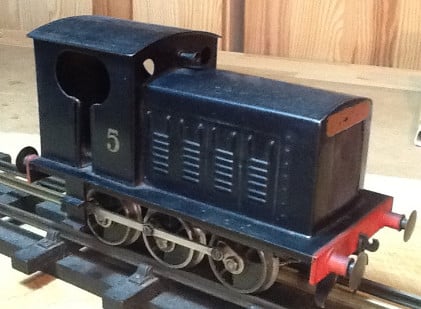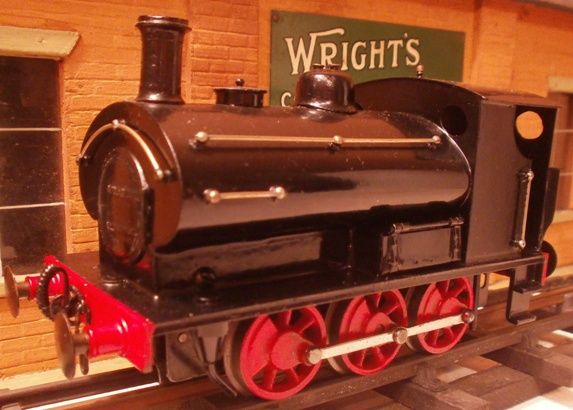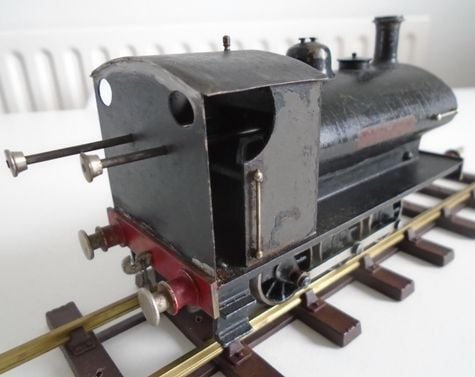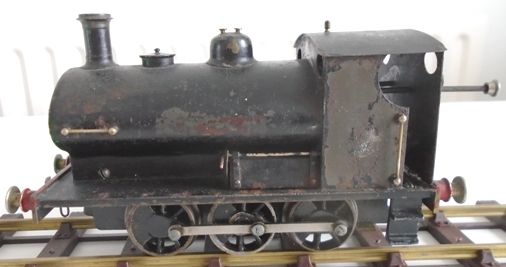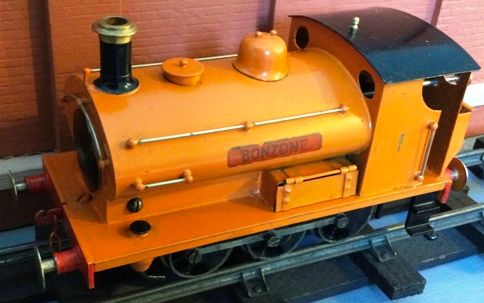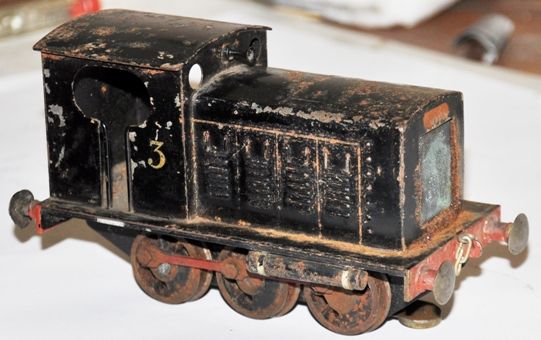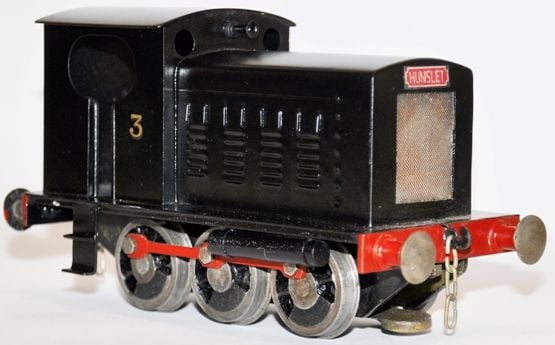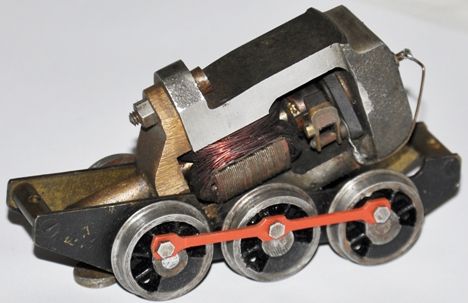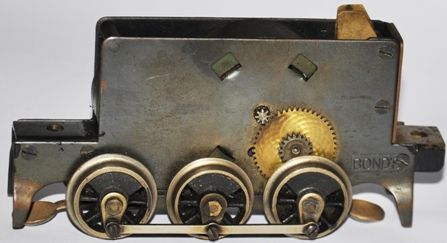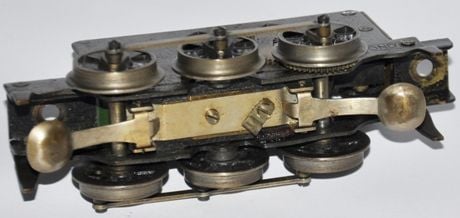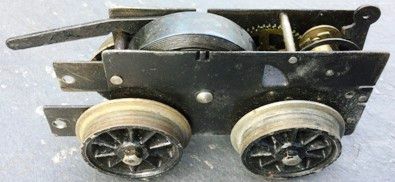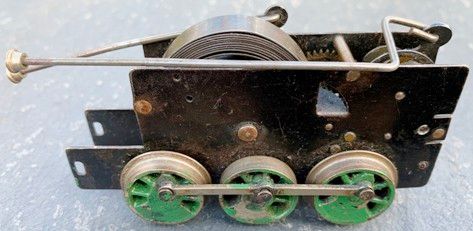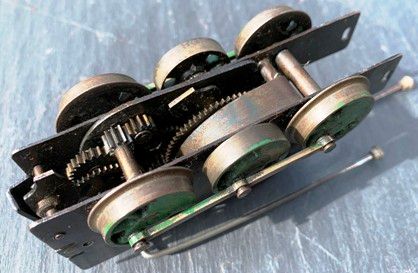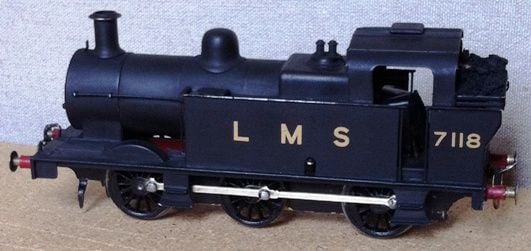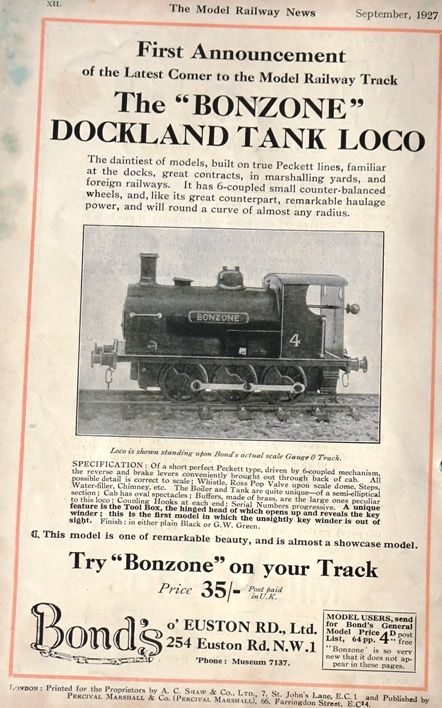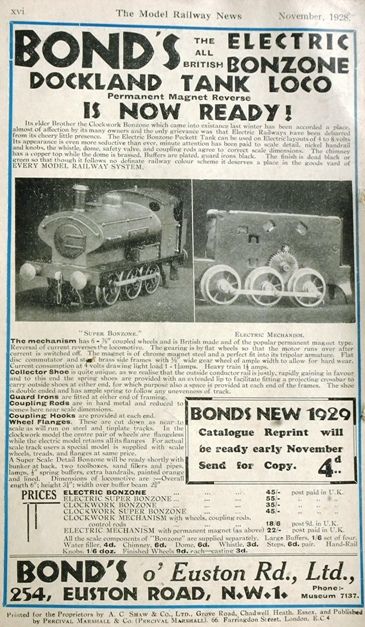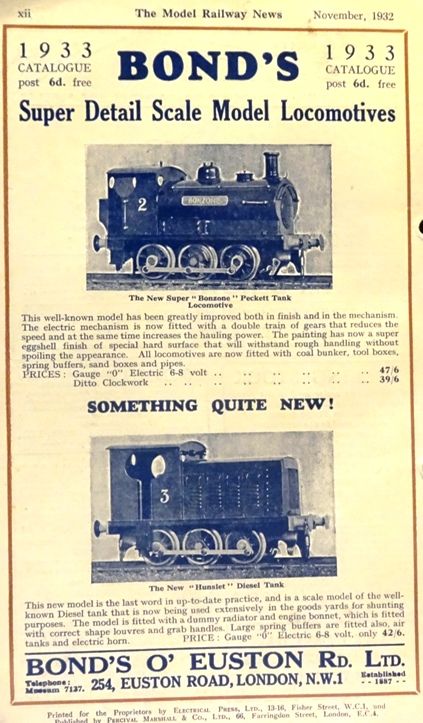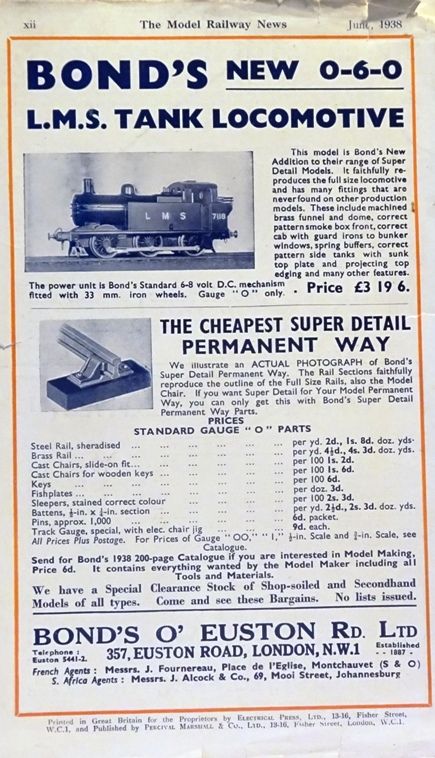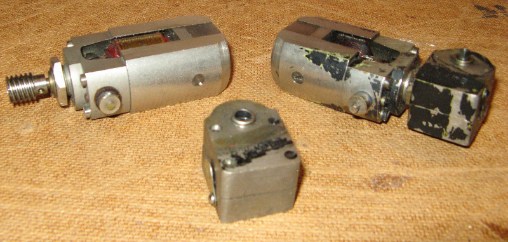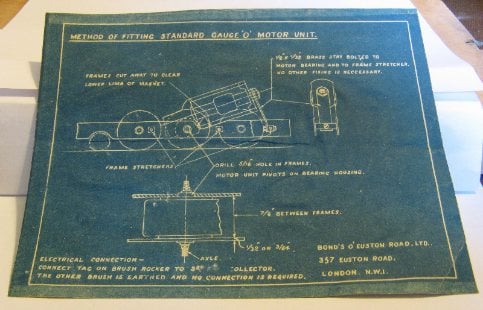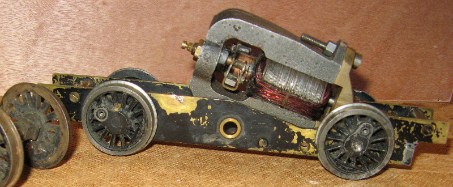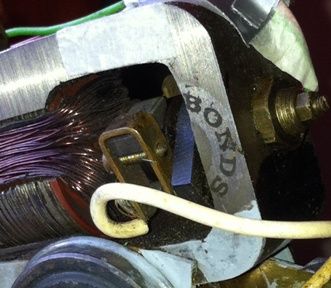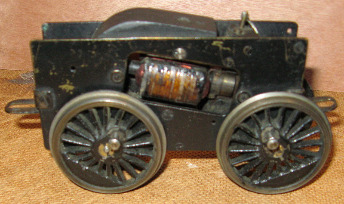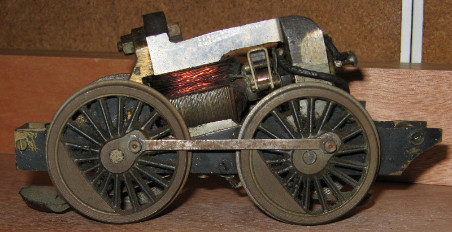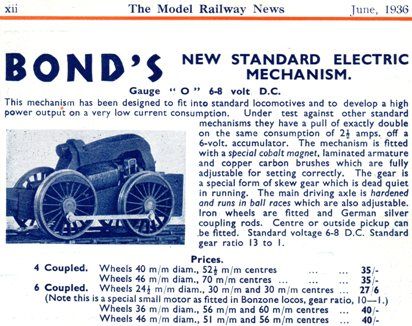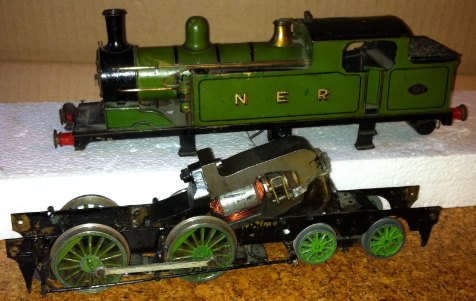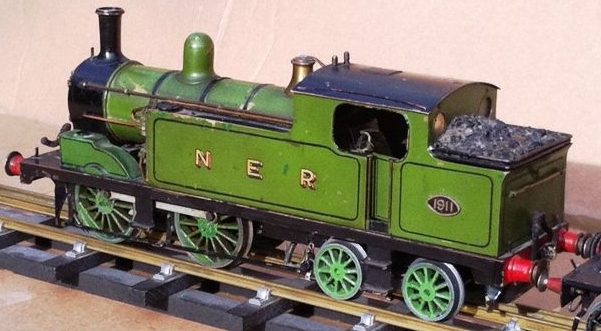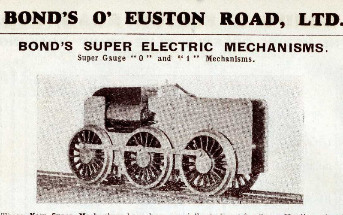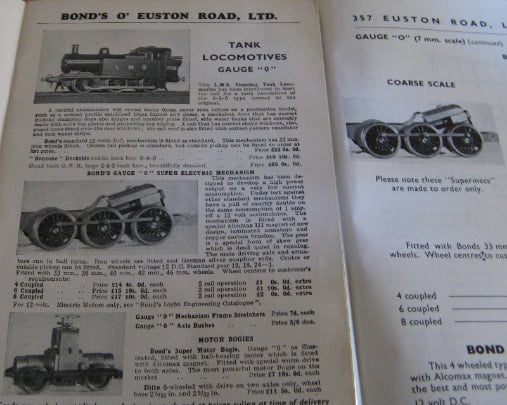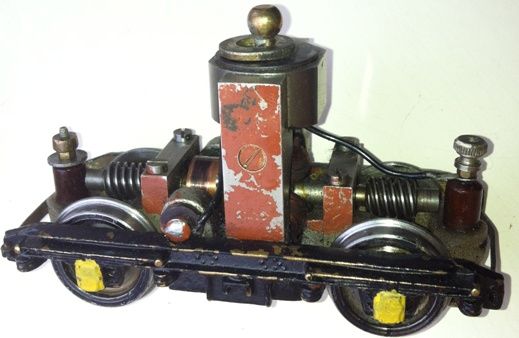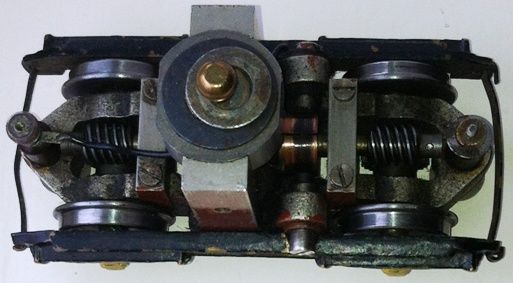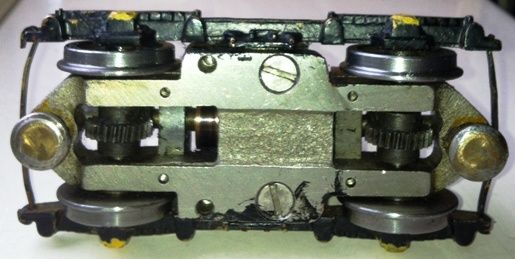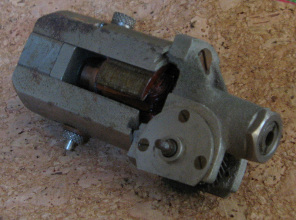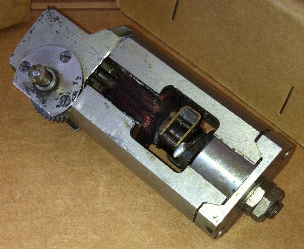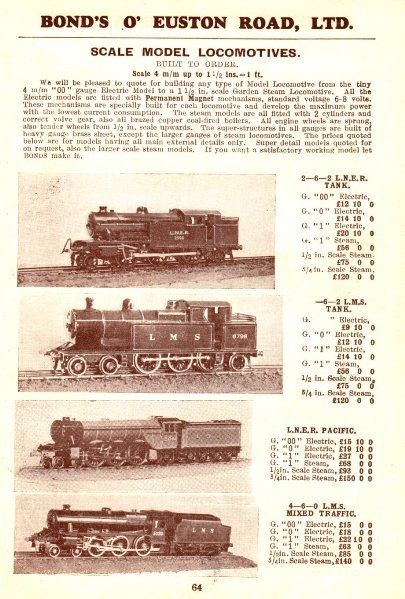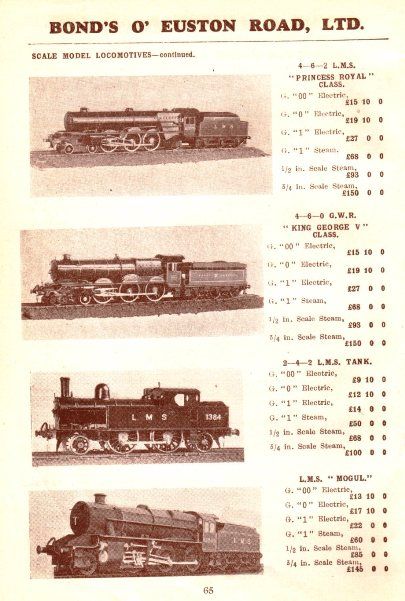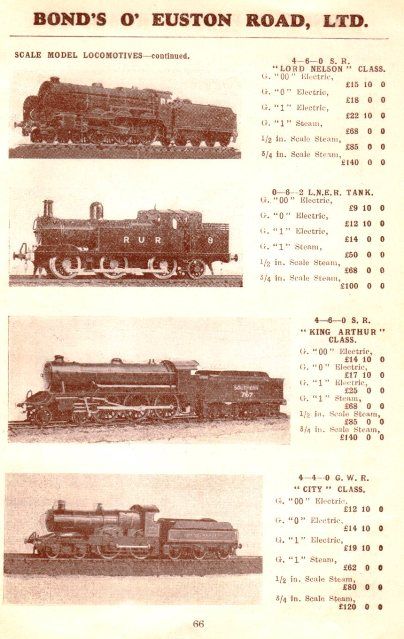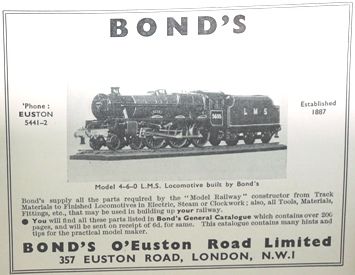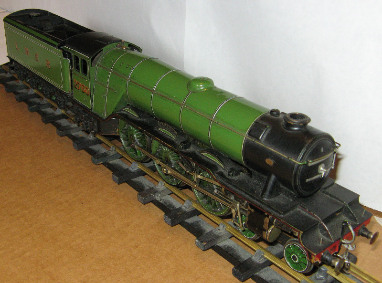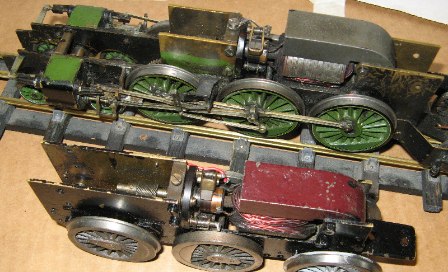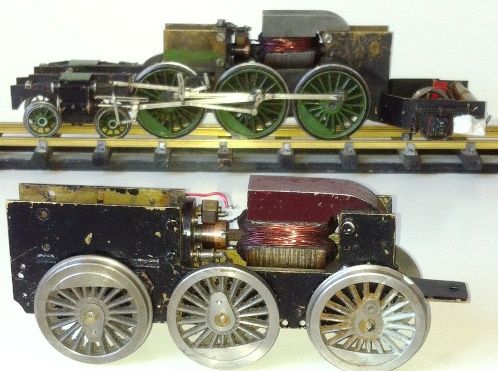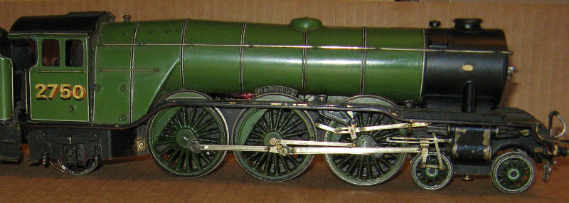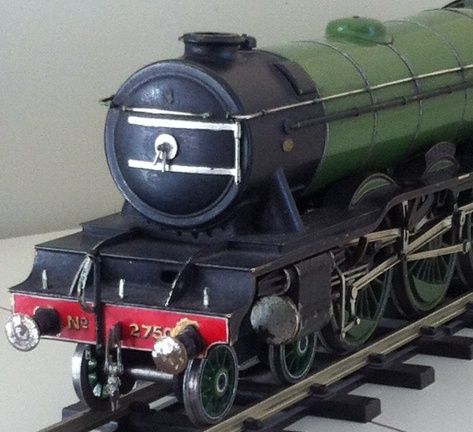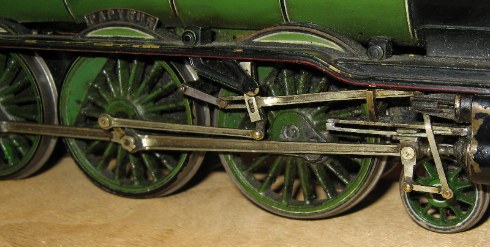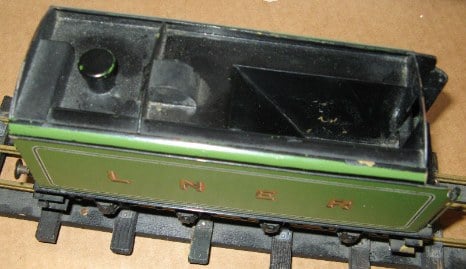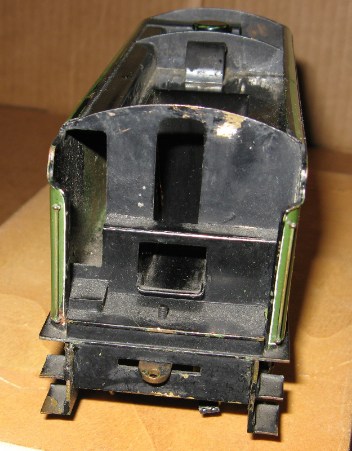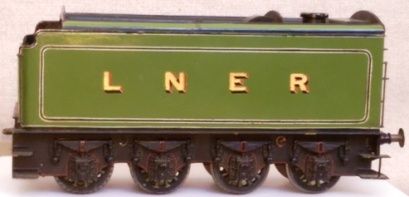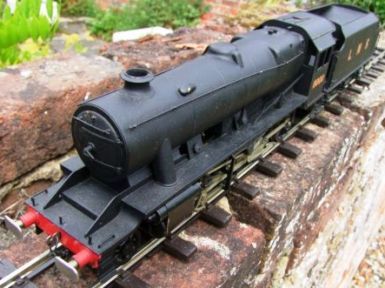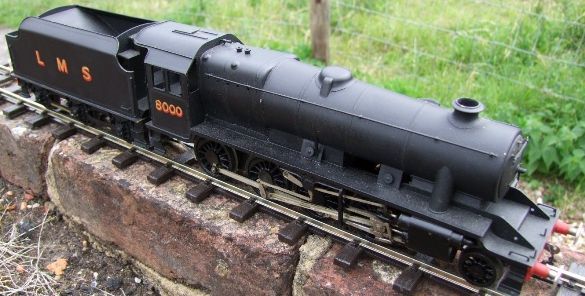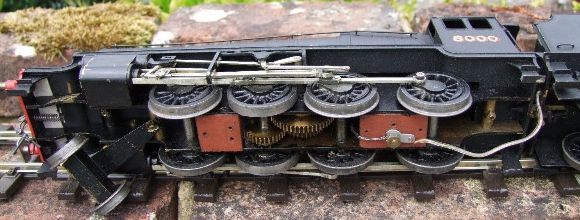
Bond's Motors and Locos**** The material here was most recently amended in November 2024 ****
Bond's motors and locomotives
Copyright is retained by M.L.Harrison for all text and photos, except for those taken by other owners and enthusiasts.
M.L.Harrison 2022 © All rights reserved.
Bond's locomotives and motors have a high reputation amongst 0 gauge model railway enthusiasts. I do not have any expert knowledge on this company's products, and what is said here is open to subsequent correction. It seems useful, however, to consider the contributions made by Bond's in this separate page, especially as there seems to be very little available in model railway books apart from a valuable section in Hammond's Guide. Thus I hope present coverage will provide some introductory material that may be of interest. There is a very useful historical commentary on Bonds by Martin Bloxsom in the Bassett-Lowke Society Newsletter of May 2014 (24, 2, pages 26-27).
Illustration Bd1. This post-war super-detailed model of an LMS pacific is well-known amongst Bond's enthusiasts, and we refer to it again later. It is a nice loco to feature at the outset of our account, because it reflects very well the high construction and detailing standards Bond's achieved in the later vintage years. Many thanks to the photographer who has let me use some pictures of the model. We refer to this engine again later.
The 'standard' small engines made by Bond's As far as 0 gauge models are concerned, the most widely-known and numerous of the Bond's engines are the 'Bonzone' saddle tanks, the Hunslet Diesel Shunter, and the LMS 'Jinty' tank loco. For excellent images see the Bond's section at the binnsroad website. Hammond's Guide gives production periods of 1927-1956, 1932-1940, and 1938-1960, respectively, for these three items (although end dates appear tentative for the first two). I have limited technical information on the electric mechanisms that went into these models over time, but a couple of these are shown below. For clockwork, a key informant has very helpfully provided us with an account of the use of Marklin units in the case of the saddle tanks.
Illustration Bd1a. Bonds Diesel Shunter. Many thanks to the owner of this loco for providing the picture. The 1936-1937 catalogue gave a price of 42 shillings and 6 pence for this model. I understand that versions may be found in several colours.
(Thanks to the owner of this loco for drawing attention to the probability that it comes from the earliest production period. I have shown both sides of the engine to make it clear that there has never been a long upper handrail as there is on the other two models pictured here. There clearly were changes in details over time. See the earliest of the 4 Bonzone advertisements shown below.)
Illustrations Bd2a, Bd2b, Bd2c and Bd3. Examples of the Bonzone saddle tank. Thanks to the three enthusiasts who provided these pictures. I am informed that the yellow model here is clockwork, with a Marklin mechanism that was modified by Bond's with 'stub axles' for the middle wheels.
Illustrations Bd4-Bd6. Pre-war models have often suffered from mistreatment or neglect, but in this case the present owner has carried through a very effective restoration project. Many thanks to this enthusiast for sending the 'before and after' photos, and for the useful picture of the engine's mechanism. Here Bond's seem to have used a fairly standard type of motor unit, but other options were also explored (perhaps at different times) when making small-loco mechanisms (see below).
Illustrations Bd7-Bd8. Two pictures of a 'freestanding' compact Bond's motor unit, almost certainly specifically designed for one of the Bond's standard small locos at some stage over their production periods. Thanks for these pictures to the person who also provided the three immediately above (Bd4-Bd6). I am informed that the size of this unit does not quite match either of the Bond's locos held by this enthusiast, but this may be explained by a variation over time in the dimensions of one of the small models, the Bonzone saddle tank.
I am grateful to a specific key informant for information about the design of the Bonzone saddle-tanks, which he explains varied over time. Locos produced just before the war (and perhaps after it) have a different shaped saddle tank to that of earlier models. Thus the 'just before the war' version has a saddle tank with straight and vertical lower sides and a higher curved top. The cab is also taller, and the chimney shorter. Our expert characterises the style of this version as being 'vaguely Andrew Barclay instead of Peckett'. The reason for the change may have been to create more head-room for the motor, and variations between motors may reflect size differences. I am informed that the clockwork motors used by Bond's seem to have generally come from Marklin, with whom Bond's clearly had commercial relationships before 1939. Our expert enthusiast advisor observes that use was made of standard Marklin 4-wheel units, with some differences and adaptations for six-wheel models, and to suit the 'Bonzone' bodies. The photographs below show the Marklin clockwork type on which the Bond's mechanisms for six-wheel engines would have been based, and an example of a six-wheeled version.
Illustrations Bd9-Bd11. A Marklin 4-wheel clockwork mechanism, together with a Bond's six-wheel example. A key informant indicates that the Marklin type was probably generally used as the basis for the Bond's six-wheel versions, with the necessary adaptations being made by the original manufacturers (Marklin) or by Bond's (or by both). I have been informed that the body of the first diesel loco shown above is of tinplate, and that the body of the second is also tinplate (and with brass buffer beams). The 'Bonzone' saddle tanks shown are also made of tinplate. In June 2016 I was able to examine closely three Bonds LMS 'Jinty' models, and found all these too to be made of tinplate. One of them is shown below; its body and steps are of tinplate but the buffer beams are of brass (and are slightly thicker). In the light of these findings, I had to revise my previous expectation that Bonds generally built their locos in brass. It seems that the catalogued cheaper standard small models were in fact generally made in tinplate, perhaps for reasons of economy. Nonetheless, they were well detailed for their period, and the Jinty had a machined brass dome and chimney. In the 1930s the firm described this LMS steam engine as having many items "never seen before on a production model", including "a smokebox door that has correct dummy clamping dogs", "hinges and number plate fitted", and "side water tanks that are correctly made with sunk top plates and projecting top edging" (Bond's Model and Experimental Engineering Handbook, 1936-7 2nd Edition, p. 56A). As is noted again below, the bodies of most Bond's scale model locos built to order at that time were in contrast generally made from "heavy gauge brass sheet" (p. 64 of the same catalogue). It is conceivable that Bond's made some other relatively inexpensive locos outside the scale range in tinplate or brass in the inter-war years, but little seems to be known about such products. As was perhaps rather the custom when some pre-war retailers described their better models, Bonds deployed the term 'super detail' when referring to the Jinty, although it would not be seen as such alongside today's super-detailed 0 gauge engines. Certainly, however, the three small 'standard' engines that formed the relatively inexpensive range seem to have been sturdy, functional and very well-designed models. They were hard to fault in 'value for money' terms, and the fact that a Jinty often turns up as a 2-rail engine testifies to their longevity as desirable running items.
Illustration Bd14. An example of the standard LMS (tinplate) 0-6-0 tank loco produced by Bonds over a long period, although (as often occurs) the model has undergone some minor change and restoration. The chassis seems to have been replaced with one containing a later (and very good) Bonds mechanism of the enclosed integral gearbox type, while the transfers have been renewed. It has also been converted to 2-rail and given more modern wheels, although it could fairly easily be put back into 3-rail form. To conclude coverage of these three excellent Bond's small locos, I have added photos of advertisements from the Model Railway News of 1927, 1928, 1932 and 1938. These seem to capture the enthusiasm of the makers and the style of the pre-war years. There is an interesting comment in the 1928 advertisement about the collector shoes then being fitted to the saddle tanks. In order to cater for outside third rail pickup arrangements, the "spring shoes" were designed to facilitate fitting a "projecting crossbar".
Illustrations Bd17-Bd20. Four of the advertisements for the small locomotives shown above. All of these were on the magazine's back cover. The 1928 reproduction has rather poor definition and I hope to improve on it later when time allows. See The Model Railway News: September 1927, 3, 33; November 1928, 4, 47; November 1932, 8, 95; June 1938, 14, 162.
As well as providing these locomotives, the company also sold models made by other firms (and identified as such), and built some specific locos themselves in response to requests. Hammond's Guide indicates that the Bond's catalogued special order locos range was offered from 1935 onwards, which means that these particular models were available (apparently) for a shorter period than the Milbro ones in the pre-war years. They were also rather expensive, although a couple of the 0 gauge prices undercut those of Mills. The catalogued Bond's LNER pacific, for instance, was priced at £19 10s in 1936-1937, as against £22 5s for a Mills one in the same catalogue years. I can add that some scale model locos of this kind seem to have been supplied before the range was outlined in the catalogue (and the same may have applied for the Mills range). In any event, locos from this Bond's series seem extraordinarily scarce.
Post-war locos Unlike Milbro, Bond's continued to be known for its model locomotive production through the post-war years up until the 1970s, although much of the company's business was apparently nothing to do with model railways. Martin Bloxsom's article (cited above) shows some examples of locos made or sold by the company as their own. The tinplate Jinty and saddle-tank discussed above remained available for some time, but there were also some highly impressive larger locos. Perhaps the most well-known post-war Bond's engine built for 0 gauge is the LMS pacific, 'City of Liverpool'. We showed a photo of that model to head this page, and feature more pictures now. I think this was created for Bond's near the start of the 1970s, and was featured in their catalogue for that period. It was made to a very high standard, apparently for a specific client, and that person is often taken to have been a Mr. Liverpool (!). I am grateful to the enthusiast and model railway expert who has provided some pictures of this loco so that we can show it here. He has set it against an appropriate background item from the full-sized loco world.
Illustrations Bd21a-Bd21d. Pictures of the well-known and highly-regarded Bond's 'City of Liverpool' model, together with a catalogue extract featuring it. Note the high standard of detailing. Many thanks to the enthusiast who provided these images, and the photo near the top of this page. As far as I know, this commissioned super-detailed loco was made in the early 1970s. It can be seen above that the attached metal plate showing the firm's details refers to 357 Euston Road. Similar pre-war Bond's plates found today would very likely have the address as 254 in the same street. As far as I can tell the change of address took place during the war. It seems that the original premises were bombed, but I have no further detailed information about the move. An earlier plate is shown below.
Illustration Bd21f. To compare with the plate shown above, I think this is probably a standard form of metal plate sometimes used by Bond's before the 1940s, although perhaps there could have been other versions too. It carries the firm's earlier Euston Road address. The plate is in a faded brown colour, and has had a lot of wear! It is just over one and a quarter inches long. There were also paper labels on some Bond's items.
In the post-war years there was some systematic outsourcing for batches of models, including contract arrangements with Vulcan of Kendal to supply J39 0-6-0 tender locos and some B1 4-6-0s. This collaboration is fairly well known, and good examples of the J39 appear from time to time. We show below a model that I take to be one of those made by Vulcan of Kendal for Bond's. (See also our section on Vulcan of Kendal.) It is very robust and heavy, with an excellent Bond's mechanism.
(The 2731 transfers are replacements for earlier ones. This model does not have any lining, but I think some examples do.)
(The tender underside is very simple, but the frames are heavy. The large tender type seems to be acceptable for a model of 2731, an engine that spent time in Scotland before its last work in East Anglia.)
Illustrations Bd22a-Bd22e. I take this to be one of the locos made for Bond's by Vulcan of Kendal. It is heavy and the body is very robust. The Bond's mechanism is excellent, and the pickups may well have been supplied by them too. I have been told that Bond's company plates were put on these models, but I do not think that was standard practice (although perhaps there may be examples known to other enthusiasts). The model is fairly simple for the mid post-war years, but these sturdy runners very likely helped fill a gap in the market as far as quite a few three-rail enthusiasts were concerned. This loco may be compared with the even simpler (and earlier) version of a 3-rail J39 we show in our coverage of Windsor Models.
It sometimes may be difficult to identify a post-war Bond's model loco with certainty without some kind of available written record, unless the model has been labelled by the company or has a clear history. This is because many post-war model-makers incorporated Bond's mechanisms into their own locos, and at least some of those engines also matched the standards set by Bond's (and could even have had fittings made by the firm). Nonetheless, various Bond's locos have been reported with certainty, and they tend to be of a high standard. We show below a handsome Great Central 4-6-0. I understand that this engine had the remains of a Bond's maker's label. I have seen pictures of another Bond's loco with a post-war paper label, and am sure they were used on some models. Unlike the pre-war models this loco seems to have wheels with slotted centres, as would be expected for most later 3-rail engines. I do not know enough to verify that the boiler fittings are by the firm, but as far as I can tell the loco certainly looks very convincing in the photo. Illustration Bd22g. A GCR 4-6-0, City of Chester, supplied by Bond's. Many thanks to the enthusiast who provided this photo and explained the identification of the model.
One question of interest for present purposes concerns differences between pre- and post-war Bond's locos. After World War Two, materials gradually shifted in model-making generally, with some firms making more use of nickel silver, but equally important was the ongoing development of motors and mechanisms. As we noted above, many post-war 3-rail models (not just those of the company itself) contain Bond's motors of modern design, so it may be helpful to show a few examples of types of mechanisms from before and after the war. Mechanisms I have not tried to assemble here any systematic list of the motors and mechanisms offered by Bonds in different periods (and there will be many enthusiasts who know a great deal more about that history than I do), but there do seem to have been several changes over time as far as mechanisms for 0 gauge were concerned. For present purposes I will start by illustrating the very successful type available in the later years. Discussion then goes on to refer to the 'Standard' and 'Super' mechanisms that were available at the time when the company produced its pre-war scale model locos range. This is followed by tentative comments on the post-war use of the term 'Super' mechanism.
Illustration Bd25. Examples of the familiar types of motors and gearbox available during the later stages of production, and popular with O gauge enthusiasts. As most readers will probably already know, a Bonds unit of this kind often represented the 'motor of choice' when models were being built or up-dated and re-engineered.
Illustration Bd26a. A leaflet advising on the fitting of a Bonds motor, to assist locomotive builders or owners.
Illustration Bd26b. This seems to have been written for a customer who had commissioned work at Bond's to re-magnetise a mechanism. It advises that it is most important that the magnet should not be removed or 'the magnet assembly loosened'. The enthusiast is told that 'Any breaking of the magnet joints results in an immediate loss of magnetism'.
When its pre-war scale locomotives range was developed, the firm had some highly distinctive mechanisms available for its 0 gauge models. The 'New Standard Electric Mechanism' was described in the 1936-1937 catalogue as including a 'special form of skew gear', and had adjustable ball races for the main driving axle. The next picture shows what I take to be one of these mechanisms, in Bond's six-wheel frames, in case some readers may not have seen one. As it is without its centre pair of wheels in this photograph, the way the brushes are held can be seen reasonably well. Standard versions similar to this one turn up occasionally in four- or six-wheel forms. I have found that when the wheels are of the heavy pressed-on type they can present problems for anyone hoping to remove them without specialised equipment! The illustration of this six-wheel mechanism is followed below by a picture of a similar one which carries a Bond's logo. Unfortunately, finding that one of these motors has a Bond's logo does not mean that the loco it sits in was made by the firm itself! The Bond's designs of this period contrast in a number of ways with the mechanisms being used by Milbro (see our section on Milbro locomotives). Until the mid-1930s, Mills mechanisms were themselves linked with the brass-framed motors that had been developed by Leeds in its earlier production period. An example of a Leeds mechanism with brass frames is shown in Illustration Bd30 below. When Milbro's later mechanism was introduced, the motor unit was very compact, and could be used without the construction of the kind of rectangular framing needed in earlier mechanisms like that shown in Bd30.
Illustration Bd27. An example of one of the pre-war types of mechanisms made by Bonds. Not all of these motors have survived in reasonable running order, and some may prove a challenge without the help of someone with good electrical knowledge and skills.
Illustration Bd28. Some of these motors carry the firm's name. This one drives the mechanism in what seems to be a scratch-built model created by someone with excellent engineering skills. Unlike the motor shown above, this one runs superbly, and seems very capable of powering what is a large and heavy LNER 2-8-0.
Illustration Bd30. For contrast. These Leeds mechanisms seem to have been widely used, and the link with what Mills made for Milbro engines up until the mid-1930s is clear. In this example there are steel wheels rather than LMC soft metal ones, but the slotted centre nut is much the same as it would be if LMC wheels were put on.
Illustration Bd32. The Bonds mechanism as set up for a four-coupled loco. This motor still runs quite well despite its age. The frames appear to have been shaped to fit a specific model, either by the company or by a purchaser, and the wheels are of the pressed-on type. One of the pick-up 'spoons' has been lost, and replaced rather crudely. It can be seen that the coupling rods are very plain (and they are also fairly thin). This was probably largely a matter of price, although it is possible that higher quality original ones may have been removed by an owner.
Illustration Bd33. This advertisement from June 1936 introduces the type of mechanism shown in our previous illustration. The wheels are of the 'press on' type, and attention is drawn to the ball races. This is from The Model Railway News, 12, 138, page xii.
Illustration Bd34. This Bonds mechanism is a variant of that shown in Illustration Bd32, and the brass frames run the full length of the model. I think it fairly unlikely that this very attractive engine is a Bond's loco (and its present mechanism seems to be a replacement for another motor), but the picture shows how an earlier standard Bond's motor unit could be incorporated in full-length framing.
Illustration Bd35. The loco needs some minor repairs to the apparatus below the body and lacks pickups. Although its maker is difficult to identify, it is a convincing model with a good number plate and other detailing.
The Bond's 'Super' mechanisms before and after World War Two The pre-war Bond's 'Super Electric Mechanisms' (see Illustrations Bd39, Bd43 and Bd44) may perhaps have represented a high point of the firm's mechanism design in the early and mid-1930s, but seem very rare today. They were apparently built individually to suit customers' own requirements. The 1931-1932 catalogue description for them was twenty-one lines long, and the price for gauge 0 was £4 10s. The company offered these mechanisms in six-wheel form, but I have not seen any picture of a four-wheel version. Unfortunately, I do not have an array of the Bonds catalogues for the late 1930s, but if there was a four-wheel version then it must have been difficult to construct. In any event, in the absence of further information it seems most likely that a mechanism like that in Bd27 or Bd32 would have served instead as the most probable pre-war power unit for some Bond's smaller tender and tank locomotives.
Illustration Bd39. The super mechanism as catalogued at the time of the pre-war locomotives range.
It appears that a transition to new mechanisms took place after the war, but I do not know whether the pre-war Super Mechanism remained available at all during the 1940s. It is worth noting, however, that Martin Bloxsom's article indicates that the company's original premises were 'bombed out' in World War Two (as we noted earlier). Unfortunately, Bond's 1950 catalogue confusingly shows what looks like an old picture of a motor of the type shown in Bd33 above, while simultaneously referring to a 'New' Super Electric Mechanism. Bond's Model Railway News advertising of the same period includes a drawing of a Bonds new '0' motor unit (e.g. in February 1950, at ii), but points out that the new redesigned motor unit differed from the illustration. The new Super Electric Mechanism was eventually referred to alongside an appropriate new photograph, showing a motor that included the 'Alcomax 2 magnet of new design' (for instance in the 1956-1957 catalogue, 15). This post-war type of mechanism seems to have remained available for a long period, and apparently survived into the 1970s, even though a range of the types of motors shown above in Illustration Bd25 had by then also been developed. The 1972 catalogue seems to include the same photograph as that shown in 1950s and 1960s catalogues (although this observation is based on a very slim sample of catalogues). Using the terms 'Super Electric Mechanism' and 'Supermec', the 1972 text states that these 'Supermecs' are 'made to order only' (p. 83; cf also pp. 18-19 for the other advanced motors). Illustration Bd40 shows parts of catalogue pages side by side from 1964 and 1972. The 1964 one shows one of the firm's LMS tank engines, and the excellent motor bogie, as well as the six-coupled mechanism. As far as I can tell, the motor shown in Illustration Bd41d is of the type featured on both these pages.
Illustration Bd40. This comparison of pages from 1964 and 1972 shows continuity as far as availability of the post-war 6-wheel 'Super' mechanism was concerned. The page on the left includes two very well-regarded other products; the motor bogie and the LMS 'Jinty' tank loco (see above). The term 'super' was also applied to the bogie. Motor bogies were advertised as being available in 6-wheeled as well as 4-wheeled forms. I assume that the bogie shown below is by Bond's, although perhaps an earlier version than the one pictured above (which looks to have enclosed gear boxes). I have no detailed knowledge of these products, but they are very impressive.
Illustrations Bd41a, Bd41b and Bd41c. An excellent motor bogie that seems to be by Bond's. I do not know when this was made.
Illustrations Bd41d and Bd41e. I think the motor in the upper picture here is a 'super' mechanism of the standard post-war type. The commutator is located at the rear, and the brushes are contained in tubes rather than located externally as on the pre-war mecanisms. The mechanisms I have had of this type have run very impressively. The lower picture (Bd41e) shows what seems to be a 'transition' super mechanism. It is very well engineered, and similar to the one shown above it, but it has arrangements for the brushes that reflect pre-war practice.
The new Bond's motors of the post-war years were compact and well engineered, and achieved widespread use. Some principles had been carried forward from the 1930s, but as far as I can tell there was no return to the old types of magnet, or to the kind of large and open gear train that had been incorporated into the pre-war Super Mechanism. This may be important when it comes to trying to determine the production period of a specific Bond's scale model loco.
Pre-war Bond's locomotives from the catalogued scale model range or linked to it The pre-war locomotives in the catalogued 'scale model' range were available in various scales from 4mm up to the larger sizes, with 'scale steam' being an option for those above 0 gauge. Those items listed by the firm would most likely have been supplemented by specific orders from customers for individual models of additional engines. According to the catalogues, brass was the material used for the super-structures (except for the steam locos in larger scales). This seems to have contrasted with practice for the three small standard models referred to above in this section of our website (and which I suggest would generally have been built in tinplate). It seems that the firm was already producing models in this range before they were catalogued in the mid-1930s. I guess that the illustrations will have been taken from items they had already made. However, 0 gauge models of large engines from this pre-war range seem very rare, and I suspect only a limited number were made.
Illustrations Bd41f-Bd41h. The Bond's pre-war range of scale model locomotives. I do not have enough of the Bond's catalogues to be sure, but I think this set of examples shown by Bond's remained the same until the war brought an end to their listing in the catalogue. See also comments in our section on Mills locos, at Illustration L1b. It should be kept in mind that some of the catalogue images here might be of locos in the larger scales as well as for 0 gauge.
Illustration Bd41j. An advertisement from the company, shown in Beal, E., 'Scale Railway Modelling To-day' (Black Ltd., London, 1939, page xxiii).
The pacific loco shown now is almost certainly an 0 gauge model built and sold by Bond's in the late 1930s as an item commissioned from their scale model range. I assume that it was made in the firm's own workshop. The loco and tender appear to be of brass. It is the only example I have been able to examine closely that clearly comes from the 1930s range, and represents a type explicitly included there.
Illustration Bd42a. Pre-war Bond's pacific Papyrus (see further pictures below). In the absence of evidence to the contrary, it seems reasonable to assume that the larger engines in this range in scales 0 and 1 would normally have used the 1930s Super Mechanism. My guess is that while the Bond's workshop would certainly have assembled frames and mechanisms for its own products, staff might also have provided either mechanism parts or complete mechanisms for use if a loco job was ever contracted out. In any event, as deployed in the loco shown here, the super mechanism is built directly into the frames. The catalogue description of the range explains that the mechanisms were specially built for each locomotive. With Papyrus the full-length side-frames (with their integral mechanism components) parallel what Mills had been doing since 1930/31. The idea of this style of construction was not Milbro's alone, but Bond's engineers may have felt the same about the advantages from the point of view of maintenance and construction. I have no way of knowing for certain whether the approach illustrated below was typical of Bond's catalogued commissioned loco models in general when a pre-war mechanism was inserted, but for the moment I am inclined to suggest that it would have been. Interestingly, the wheels on Papyrus appear to be pressed on. As with Exley, this was probably common for Bond's in this period. Illustration Bd42b. Another full-length picture of LNER pacific Papyrus. I believe this engine to have been made in the second half of the 1930s. It is a beautiful locomotive, and its paint finish has lasted well, albeit with some nasty damage to the metal at one point above the boiler. The previous owner had converted it to two-rail running, and made some amendments inside the loco and below the tender. Despite this, he retained the original frames and mechanism, as can be seen below.
Illustration Bd43. This shows the chassis and built-in mechanism of the loco. I have put alongside it a 'freestanding' 1930s Bond's 'Super Electric Mechanism', so that the viewer can see at once what has been done. The 'achilles heel' of these impressive pre-war motors was probably the system for the brushes. It seems odd that the designers of a motor with ball races and sophisticated gearing should have come up with such an under-developed and potentially precarious arrangement for holding things in position. An interesting feature of the motor and its gear train is that for this pacific it connects to the axle of the front driving wheels. This contrasts with what I would expect for a large Milbro engine. See for example our Milbro locos page, Illustration L39.
Illustration Bd44. From a different angle. The wheels on the front mechanism are not original, but its origin is confirmed by the stamped name of the company on one of the frames.
Illustration Bd45. Loco side view.
Illustration Bd46. Front end details.
Illustration Bd47. Nameplate, wheels and motion. I am informed that conversion of vintage locos to two-rail running could mean altering the wheels by cutting through spokes; perhaps that was done for this engine.
Illustration Bd48a. The tender.
Illustration Bd48b. Tender front view.
Illustration Bd48c. The tender's paintwork is still in good condition.
Another excellent Bond's loco that is thought to have been made before the war is shown below. It is a 3-rail LMS 8F.
Illustrations Bd49a-Bd49d. I am grateful to a previous owner of this model for permission to use his excellent photographs here. They appeared on Ebay when the loco was auctioned in 2017. The narrative given to me via another past (earlier) owner suggested that the model was apparently sold by Bond's just before the second world war. If that is correct, then the loco might well be expected to contain something similar to the mechanism of Papyrus shown above. Our fourth photograph suggests that the locomotive not only appears to have 'pressed on' wheels, but a complex gear train built directly into the frames, rather than a later postwar motor unit. I would need to be able to examine the model more directly to check further its similarity with Papyrus. As can be seen, the Bond's pickups have been removed from the two pickup blocks.
The discussion above does not preclude finding brass Bond's 0 gauge locos from the 1930s or early post-war years that are fitted with simpler mechanisms from the same periods. That might have arisen in order to meet a lower price, or simply for convenience with a smaller loco body. I hope to show an example when time permits.
|

